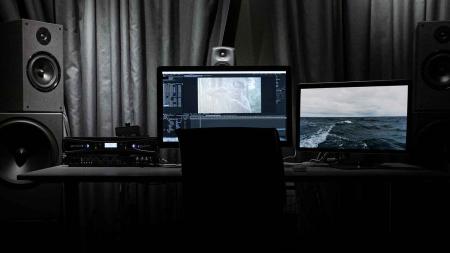
Related Class
Best Laptop for After Effects
- Published on

The best laptop for After Effects comes from an unlikely source that animation and effects professionals will likely find surprising. After Effects is an extremely processor and graphics intensive application, making it challenging to find a good laptop for After Effects. You might expect the best laptop for After Effects to be from a hardware vendor that has been creating laptops for many years such as Apple, Dell, HP, Lenovo, or Toshiba. Yet the best After Effects laptop we have found comes directly from relative newcomer to the hardware business, Microsoft. They have an updated laptop that goes well beyond a general use computer that that simply runs Microsoft Windows and their Office apps. With the Microsoft Surface Book 2, they have created a laptop that runs the most demanding third-party applications, such as CAD, Photoshop, and After Effects. The Surface Book 2 is a complete laptop that also doubles as a tablet, and a significant upgrade from the original.
The evolution of a powerful laptop for After Effects
The Surface Book 3 is quite different from Microsoft’s initial versions of this laptop, the Surface Pro, which was not well equipped for the needs of After Effects. There are similarities, with both including touch screens, digital pens, and the ability to operate as either a computer or tablet. The internal processors, ability to handle graphics-intensive tasks, and battery life are quite different.
The original Surface Pro did not include a dedicated graphics processing unit (GPU). It also did not include dedicated memory for graphics related tasks. This left the primary processor and primary memory to be shared for both regular tasks and graphics tasks. This creates a bottleneck that slows down applications such as After Effects and certain functions in other Creative Cloud applications such as Premiere Pro and Photoshop. The Surface Book added a dedicated GPU, and the Surface Book 2 increased the power of the GPU and dedicated graphics memory that is needed.
Laptop with Dedicated GPU for After Effects
Microsoft added a dedicated Nvidia Graphics GPU, sometimes called a discrete GPU, to the Surface Book along with dedicated graphics memory. This was added into the detachable keyboard with additional batteries. When attached to the keyboard, the laptop with a discrete GPU helps After Effects to perform rendering tasks dramatically more quickly. Instead of waiting for animations or effects to render, After Effects is able to quickly perform the most demanding tasks. The GPU is important not just for laptops, but even in desktop computers. In the labs and classrooms where American Graphics Institute teaches After Effects classes, computers with GPUs are the norm.
Surface Book or MacBook Pro for After Effects
If you work exclusively in a Mac environment, consider the high-end MacBook Pro for After Effects. The 15 inch model includes a dedicated GPU, using the AMD Radeon R9 M370X instead of the Nvidia used in the Surface Pro. The 13 inch MacBook Pro does not include the dedicated GPU, which leaves the larger system as the only valid MacBook Pro to compare against the Surface Book as a suitable laptop for After Effects. The MacBook Pro has a larger screen and sports 2GB of graphics memory with the discrete GPU, but lacks the detachable keyboard, touch-screen, and pen, and has a shorter battery life. If you need a truly portable system, the smaller 13 inch Surface Book wins on both size and battery life for running After Effects.
HP ZBook Fury for After Effects
The HP ZBook Fury is our runner-up for After Effects laptops. It provides a larger screen, two dedicated cooling fans, and your choice of GPU for graphics processing. The size of this laptop makes it a better choice for a desktop computer that may sometimes need to be used as a portable, rather than a truly portable computer. Otherwise, the HP ZBook Fury is a well-equipped laptop and a good choice for running After Effects or Premiere Pro.
About the author
Christopher Smith is president of American Graphics Institute. He is the co-author of Adobe Creative Cloud for Dummies and more than 10 other books on design and digital publishing. He served as publisher and editor of the Digital Classroom book series, which has sold more than one million books on topics relating to InDesign, Photoshop, Illustrator, After Effects, Premiere Pro and other Creative Cloud apps. At American Graphics Institute, he provides strategic technology consulting to marketing professionals, publishers designers, and large technology companies including Google, Apple, Microsoft, and HP. An expert on web analytics and digital marketing, he also delivers Google Analytics classes along with workshops on digital marketing topics. Christopher did his undergraduate studies the at the University of Minnesota, and then worked for Quark, Inc. prior to joining American Graphics Institute where he has worked for more than 20 years.


